Virginio Vespignani (1808-82)
Umbria: Home Cities History “Foreign” Architects in Umbria Hagiography Contact
Virginio Vespignani in: Orvieto


Virginio Vespignani (1808-82)
Umbria: Home Cities History “Foreign” Architects in Umbria Hagiography Contact
Virginio Vespignani in: Orvieto
The Roman architect Virginio Vespignani was appointed as Architetto del Popolo Romano in 1838, under Pope Gregory XVI. He continued to prosper under Pope Pius IX (1846-1878), particularly after the fall of the Roman Republic in 1850, when Pius IX undertook the “Renovatio urbis” (renovation of the papal capital). He was centrally involved in the tour that Pius IX made of the Papal States in 1857.
Virginio Vespignani continued to prosper in the early years of the united Italy, despite the fact that, as an ardent Catholic, he refused to accept commissions from the new government. He designed the new facade (1863) of the Cappella del Miracolo, Bolsena, without charging a fee, because the structure was needed for the annual celebration of Corpus Domini once Orvieto was in anti-papal hands.
Orvieto
Bishop Giuseppe Maria Vespignani (1842-65) probably encouraged his brother Virginio to work in Orvieto. In particular, both men were heavily involved in the preparations for the visit of Pius IX to Orvieto in 1857.
Work on Teatro Comunale (1853-63)
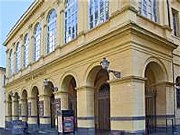
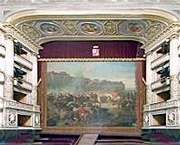
The local architect Giovanni Santini built the original Teatro Comunale in 1841 as a private commission. However, the Town Council took over the project and commissioned Virginio Vespignani to redesign and rebuild it in 1853. This is one of three theatres designed by Virginio Vespignani. The others are:
✴il Teatro dell’ Unione, Viterbo (completed in 1855); and
✴il Teatro Rossini, Rome (1873).
In Orvieto, he largely followed the floor plan of the earlier structure, but he completely redesigned the facade in what became Corso Cavour.
Virginio Vespignani suggested that the interior decoration (1863-6) should be commissioned from the Perugian Annibale Angelini and the Orvietan Cesare Fracassini. The latter painted the theatre curtain, which depicts the Byzantine General Belisarius freeing the city from the Goths (the first documented event in Orvieto’s history). The theatre opened in 1866.
In 1922, the theatre became known as Teatro Mancinelli in honour of the composer Luigi Mancinelli (died 1921), who was born in Orvieto.
Arco del Palazzo Comunale (1857)
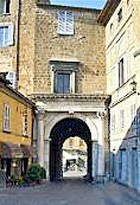
The surviving arch has two columns with Corinthian capitals, and a flat entablature at the level of the piano nobile of Palazzo Communale (to the right in this photograph).
Palazzo dell’ Opera del Duomo (1857)
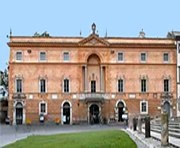
The Opera del Duomo acquired the premises that later formed the left hand part of this palace in 1356. The space in front of these buildings was cleared in 1556, and a new Palazzo dell’ Opera del Duomo was built in 1623-9. [The portal to the right of the present palace bears the date 1623].
The Opera acquired properties to the south of the original palace (to the right in this photograph, on the other side of what was then Via del Migliarino) in the 19th century. The impetus for the expansion came from a desire to make the archives and the objects of art that belonged to the Opera available to the public. The design (1857) by Virginio Vespignani for a facade that would unify both wings of the palace survives in these archives. A central arch above Via del Migliarino enclosed a loggia for papal benedictions. A fresco of the Immaculate Virgin was planned for the back wall of this loggia: Pope Pius IX had confirmed the dogma of the Immaculate Conception in 1854.
In fact, the nascent Museo dell' Opera del Duomo moved to Palazzo Soliano in 1897. A photograph taken in the following year shows that the loggia had been built by that time, but that the facade to the right of it was incomplete. The facade took on its present symmetrical appearance during a further remodelling by Paolo Zampi in 1898-9. He modified the windows in the new part of the facade to match those that survived from the 17th century structure, introduced the central portal and abandoned the idea of fresco for the loggia above it. A huge travertine block was ordered for the base of the loggia in 1900. The arms of the Opera del Duomo appear at the pinnacle above this loggia.
A further wing was added at the rear of the building in 1905-6. The palace still houses the archives of the Opera del Duomo and also hosts the Tourist Office.
Facade of Palazzo Ravizza (1857)
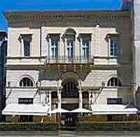
Santa Maria dei Servi (1857)
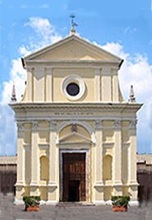
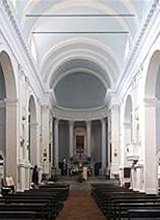
The Servites abandoned the original church of Santa Maria dei Servi after it partially collapsed in 1830. It was left in ruins until 1855, when the Provincial Chapter (meeting in Perugia) decided to rebuild it. In 1857, Virginio Vespignani was commissioned to design the new church in the neoclassical style, no doubt at the suggestion of his brother, Bishop Giuseppe Maria Vespignani. Work was halted by the civil unrest of 1860, at which point the complex passed to the civic authorities. At this point, the facade remained unbuilt.
The complex was used as a barracks until 1870, when it was put up for sale. The structure was then undermined by an earthquake in 1873. A priest called Padre Francesco Riscossa bought it at auction later that year, and restored it with financial help from Giuseppe Bracci. The completed church, which served the surrounding parish, was consecrated in 1875.
Palazzo Bracci (1875-81)
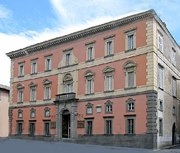
Virginio Vespignani built the neoclassical Palazzo Bracci for Giuseppe Bracci Testasecca, the man responsible for financing the funicular railway of Orvieto. Towards the end of the century, the palace was adapted as Hotel Reale, where King Umberto I stayed in 1891.
The portal (17th century) survives from the earlier palace on the site.
Read more:
C. Barucci, “Virginio Vespignani. Architetto tra Stato Pontificio e Regno d' Italia”, (2006) Rome
Return to the page on Art in: Orvieto.
Return to “Foreign” Architects in Umbria.